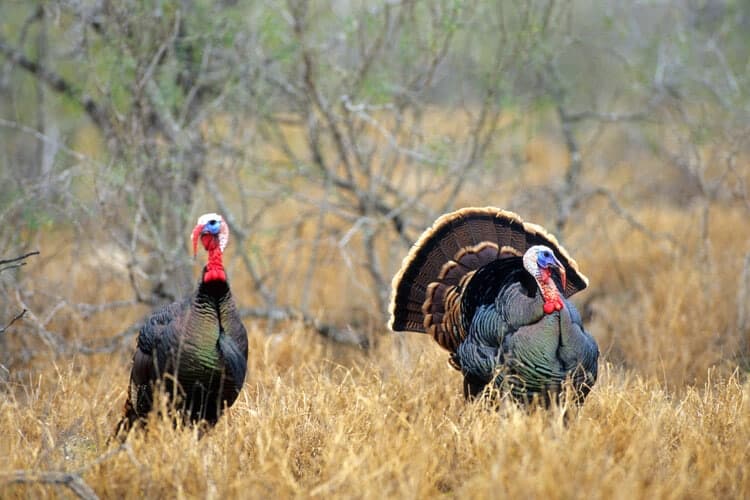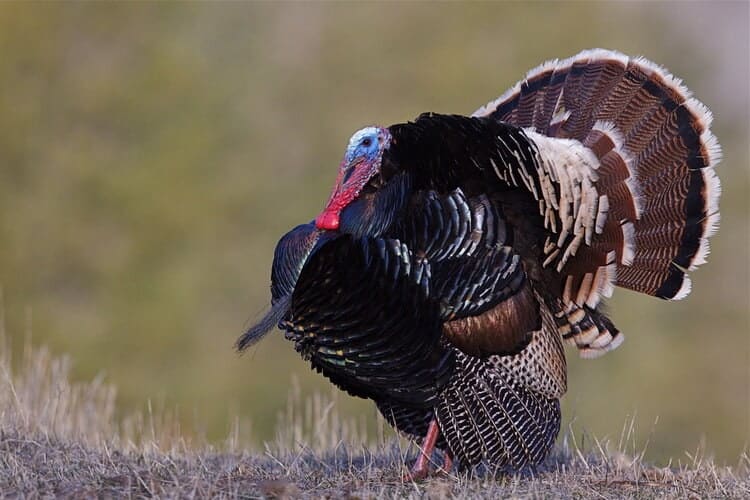Have you heard the phrase “strut your stuff”? It means to show off what you’re good at by doing it with pride and confidence. What does that have to do with turkeys? “Strutting” is the word for when a turkey puffs up its feathers. This is what makes this bird go from bland to grand.
Indeed, turkeys exhibit this fascinating behavior to attract mates, show their dominance, or defend against predators. Let’s look at each of these reasons in more detail.
Seeing a turkey with its feathers puffed up is a common sight, especially during mating season. This strange behavior actually has an important purpose for the turkey. When a male turkey (also called a tom or gobbler) puffs up, it is communicating a few different things to other turkeys and potential threats.
Why Turkeys Puff Up Their Feathers
Turkeys puff themselves up for a few key reasons
- To attract females and show dominance over other males during breeding season
- To make themselves look larger and more intimidating to predators or rivals
- To express alarm or react to a perceived threat in their environment
- To regulate their body temperature and stay warm
When a male turkey fans out his tail feathers and ruffles all his plumage, it creates a dramatic display This puffed up feathering makes the tom appear much bigger than his normal size By enlarging his profile, he hopes to both attract female turkeys and intimidate competing males when trying to mate.
Typical Puffing Up Behaviors
There are a few typical behaviors you may witness when a turkey puffs itself up:
- Strutting around with feathers fanned out and tail spread wide
- Erecting feathers to increase apparent body size
- Gobbling loudly and making aggressive noises
- Charging or chasing after other turkeys or animals
- Posturing and showing off to seem intimidating and formidable
These actions all tie into the turkey’s goals – looking strong and vigorous to entice hens and seeing off opponent toms during the breeding season. The strutting and vocalizations draw the attention of females while the enlarged size deters competing males. Even though the turkey hasn’t grown, expanding its feathers makes it look over twice as big!
Seasonal Puffing Up
Turkeys are most likely to puff themselves up and display these dominant behaviors during spring mating time. When the breeding season arrives, male turkeys are flooded with testosterone, putting them in the mood for attracting mates. They fan out to cover maximum ground when seeking females and defending territory from other lusty males.
You may see toms puffing themselves up any time of year, but mating season is by far the peak. As autumn approaches, the testosterone levels drop and males become less aggressive and competitive. They no longer have a need to strut for dominance or reproduction. Though threats can still cause a fearful turkey to puff up year round, it’s rarely as pronounced outside of spring.
Why Females Puff Up
It’s not just the male turkeys who puff up. Hens will also fluff out their feathers, though not to the same dramatic extent. Female turkeys generally stick to a subtler version. Rather than the pronounced strutting and posturing of males, females may softly erect their body feathers while moving slowly and deliberately.
A female may puff up for a few reasons:
- To signal receptiveness and interest to males during mating season
- To appear larger and more aggressive if defending chicks or territory
- To ward off unwanted advances from an amorous male
- To regulate body temperature just like males
While male turkeys puff up to boast, females do it to protect. An expanded momma turkey can chase away predators or overzealous male turkeys that get too close and pose a threat to babies. With a soft puff, she can also non-verbally indicate her readiness to mate without excessive display.
Warming Up With Feathers
Along with communication, puffing up feathers allows turkeys to trap body heat and stay warm. Turkeys spread out their plumes to trap air, which helps insulate them against cold weather. You may see this fluffy appearance more often in winter as the birds try to warm up.
When the temperature drops, turkeys need their feathers to regulate temperature. The feathers expand to hold heat close to their bodies. You won’t see as much dramatic posturing, but the bird will get noticeably poofy even when not signaling mating or aggression.
Alarm Puffing
Sudden perceived threats will cause a turkey to instantly puff up in alarm before taking any other action. Loud noises, approaching predators, or unknown stimuli can trigger a fearful reaction.
When alarmed, a turkey will rapidly ruffle all its feathers. This makes the turkey appear instantly bigger in hopes of scaring off the potential threat. The puffed state allows the turkey to then decide whether to face the intruder or flee the area.
This reactionary puff-up generally only lasts a few seconds before the turkey relaxes or acts. But in that instant, the feathers erect to prepare for conflict or escape. It’s a natural instinctive response before the turkey consciously makes its next move.
How to Read Turkey Body Language
Knowing what it means when a turkey puffs up allows you to better understand turkey behavior. Here are some tips for reading turkey body language:
-
A fully puffed male strutting about is showing breeding behavior. He’s virile and seeking to mate.
-
A puffed up dominant male charging others is expressing aggression and trying to fight.
-
A female subtly puffed up and walking slowly may be signaling receptiveness for mating.
-
Fluffed up feathers in cold weather just means the turkey is keeping warm.
-
Sudden, fast puffing likely signals alarm and preparation to face a threat.
-
Relaxed smooth feathers indicate calmness and contentment within the flock.
Reading turkey body language provides insight into how they communicate. Whether it’s for breeding, fighting, warming up, or alarmed reaction, puffing feathers is an important non-verbal signal for turkeys. With practice, you can learn to interpret their unique displays.
So next time you see a puffed up turkey, take a closer look and analyze what it may be communicating. The context and behaviors around its expanded feathers can paint a real picture of the turkey’s motivations and mindset. Careful observers can learn to translate the turkey’s unspoken language!

The 3 Reasons Turkeys May Puff Up

In general, strutting is associated with the breeding season: male turkeys inflate their feathers and spark their colors to wow females. This is not, however, an atypical behavior in the animal world; many male birds seem to be more favored by nature than females. Indeed, males generally sport a more shimmering and flamboyant plumage than females and also possess other characteristics that allow them to impress their female counterparts. This flamboyant manifestation of virility always has the same goal, that of attracting a female to lead to eventual mating.
Moreover, in the case of turkeys, it is not only mature males who have the ability to strut: optimistic young gobblers may also strut around in the presence of hens in the vain hope of stimulating a breeding session.
What Are the Characteristics of the Strut?

You may have seen pictures of turkeys strutting around, or you may have seen them do this many times while hunting in the wild. In any case, here is a small summary of the characteristics of strutting:
- The turkey first lowers its main feathers until they touch the ground.
- Then she forms a fan with her tail.
- She stands all of the feathers on her back and chest up straight.
- She lowers her head and neck in an “S” shape.
Additionally, at the base of each feather are small muscles that allow turkeys to move their feathers. These muscles are connected to other very small muscles in the skin. So, when a turkey struts, she contracts the muscles that control the position of the feathers, causing the body’s feathers to stand up.
The turkey is now ready to impress females or intimidate rivals!
What does it mean when a turkey puffs up?
FAQ
Why do turkeys make a puffing sound?
How can you tell if a turkey is happy?
Do girl turkeys puff up?
Why do turkeys puff up?
Be it pet or wild, the puffing up which is also known as strut behavior has commonly been witnessed among turkeys. And predominately this behavior is manifested by a male turkey. Male turkeys puff up their feathers while pulling their wings and fan the tails exhibiting colorful long features to entice female turkeys for mating.
Why do male turkeys puff up their feathers?
Male turkeys puff up their feathers while pulling their wings and fan the tails exhibiting colorful long features to entice female turkeys for mating. Male turkeys display this puffing up or mating dance mostly during the period of breeding so that the female turkeys turn their head over heels towards the male turkeys for mating.
How do you know if a Turkey is puffing up?
The first sign that can help you identify puff up in turkeys is that noticing the turkeys drop their wings in the first place to touch ground. Another sign of recognizing puffing up in turkeys is that catching a glimpse of holding the feathers of their tail in a vertical position.
Why do Hen turkeys strut their feathers?
A few hunters have observed hen turkeys strut their feathers too, but that is a rare occurrence. It is usually a response to another aggressive hen or any other strong stimulus. A predator threatening a brood of chicks can be a reason.
How do you know if a Turkey is a gobbler?
The bird will hold its tail in a vertical position and spread its tail feathers to form a fan. The gobbler will place all the back and breast feathers in an erect position, making him appear larger. The head, naked skin and caruncles of a wild turkey may range from blue to bright red or flesh tone. The bird’s crown is usually pure white.
How do you know if a Turkey is aggravated?
Reading the turkey’s body language right can be a great advantage for a hunter in such scenarios. In my experience, the twitching of the wings is one sign that indicates that the bird is aggravated. The other obvious sign is the change in head coloration. If the head color is white, light red, or blue, the bird is relaxed.
